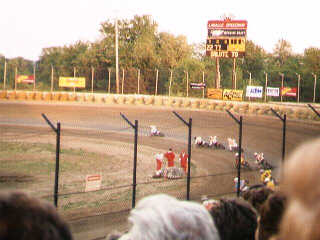
SPRINGFIELD, Illinois, September 5-6 -- Stock-car racing may be the most popular spectator sport in the United States, and the Indianapolis 500 may be the most famous race in the world. But in terms of excitement and competition, nothing beats dirt-track motorcycle racing.

I became interested in dirt-track largely because I moved to the Midwest; there are more professional dirt-track events in Illinois than in any other state. This picture was taken last year at LaSalle Speedway, a short track located some two hours southwest of Chicago. The Indianapolis Motor Speedway of the dirt-track world, though, is the Springfield Mile, at the state fairgrounds, where Meg and I attended a race weekend over Labor Day. The Springfield Mile weekend included 27 races, not counting qualifying heats. Many, if not most, of these races, were decided by less than a bike-length, which is pretty much the way it usually works -- how many other forms of motor sport can say that?
Dirt-track racing bikes are stripped down to the essentials -- a torquey engine in a light frame. The bikes are pretty low-tech, compared to Grand Prix race cars, Indy cars, today's NASCAR entries, or Grand Prix roadracing motorcycles (which can cost hundreds of thousands of dollars apiece). At Springfield, Scott Parker, who has won the AMA Grand National points title eight years running, announced that he had just sold one of his race bikes -- for $25,000. Try buying Jacques Villeneuve's car for that kind of money!
There's no telemetry, no microchips, not much in the way of aerodynamics, and everyone's pretty much riding the same bike. (That's partly due to the American Motorcyclist Association's archaic rules -- but that's a subject beyond the scope of this column.) So it's me against you, my tuner against your tuner, on machines that aren't all that different from something you could ride on the street.
The racers aren't riding for huge bucks, either. At Springfield this fall, one of the main attractions was the first-ever Dirt Track Hall of Fame race, which featured 15 of the top riders in a 10-lap sprint for a $50,000 purse -- the biggest purse in the history of dirt-track racing. The winner's share came to something like $15,000 -- not bad for a day's work, but chicken feed compared to what Jeff Gordon earns every time he wins a Winston Cup race. These guys are in it because they love to race, not because it's a path to fame and fortune.
Another appealing aspect of dirt-track racing is that it isn't just for infants. As of this week, the four top riders on the Grand National circuit are Will Davis (33), Rich King (35), Scott Parker (36), and Chris Carr (31). Among the other top riders, Jay Springsteen is 41, Steve Morehead is 43, and Terry Poovey is 40. Not being as young as I used to be (see "How did I get here?," April 28th), I like to look for evidence that I'm not over the hill -- how could I be, when guys who are older than I am can still win racing championships?
'Round and 'round we go
I've always been partial to road racing in the past, largely because it bears more resemblance to driving on the road. Going around and around in an oval, no right turns needed, always seemed less than exciting, when cars were doing the driving. But with motorcycles, it's a different story entirely, because the rider-vs.-rider competition is so intense. In the 25-lap Grand National main event at Springfield, I lost track of the number of lead changes, but there must have been at least 40. With all the drafting that goes on, the rider who leads at the start of a straightaway almost never leads at the end -- it isn't unusual to see a rider go from 4th or 5th place to first in one straight.
The AMA puts on a good show, at the Grand National events. The races are essentially sprints -- the main event, as noted, is only 25 laps and takes less than 15 minutes. The track announcer is a folksy, enthusiastic guy who keeps new fans informed but doesn't get tiresome if you already know the drill.
And beside all that, it's not hard to get tickets, and you don't have to fight your way through huge crowds and traffic jams to get in and out of the racetrack. Put it all together, and a weekend at the Springfield Mile is the best deal in racing. Why, then, isn't it more popular? Probably because motorcycle racing itself has an undeservedly narrow appeal. Mingling with the crowd at Springfield, Meg and I guessed that there were very few non-motorcyclists in attendance. People who don't ride don't tend to want to watch motorcycles. We speculated that dirt-track racing could probably become a much more popular sport if wagering were introduced. This sounds like a strange idea, but it's not all that farfetched -- oval-track motorcycle racing for wager is a big-money sport in Japan, although you'd never know it from the lack of press coverage the sport receives.
Be that as it may, the stock cars, Indy cars, and Formula 1 Grand Prix racers may get the attention -- but dirt-track motorcycle racing is the best show going.
Copyright © 1998 John J. Kafalas